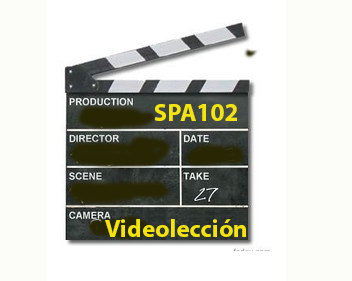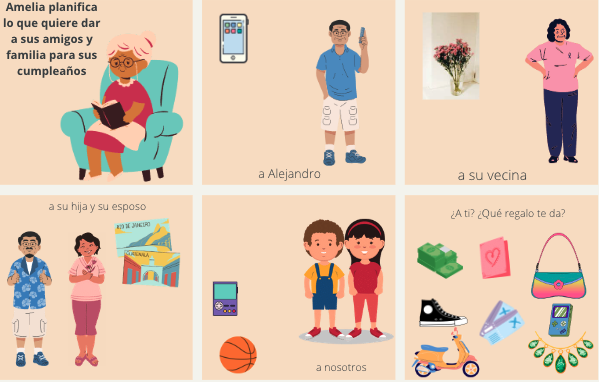4.9: Los objetos indirectos y los pronombres de los objetos indirectos
- Page ID
- 150047
Indirect object nouns and indirect object pronouns
Indirect objects
In a sentence, an indirect object is the noun in the sentence that often receives the direct object of the verb. It can answer the question "to whom or for whom" the action is done. In the graphic below, you see a typical word order in Spanish for a sentence that has both a direct object and an indirect object, which is highlighted in blue. What is David buying? The tickets, which is the direct object of the sentence. For whom is he buying the tickets? For his parents, which is the indirect object of the sentence.

There are a couple of things to note:
1) In Spanish, even though the indirect object is fully spelled out, it is most often accompanied by its corresponding indirect object pronoun as well. The indirect object noun is used to emphasize or clarify "to/for whom" the pronoun refers.
2) The word "a" can mean "to" or "for" and is placed directly in front of the indirect object.
In the example below, "a mí" is now the indirect object of the sentence, and the indirect object pronoun changes to "me". The "a mí" in the sentence adds emphasis, but it is not necessary in the sentence.

Indirect object pronouns
- Indirect object pronouns are words that replace indirect object nouns in order to avoid repetition. The indirect object pronoun is often used without the indirect object noun when the person for whom the action is being done is known. The forms of the indirect object pronouns are provided below.
| Singular | Plural |
|---|---|
| me = (to, for) me | nos = (to, for) us |
te = (to, for) you (familiar)  |
 |
| le = (to, for) you (formal); him; her | les = you all (formal); them |
- Since "le" and "les" have multiple meanings, "a" + [noun] or "a" + [pronoun] is sometimes used to clarify to whom the indirect object pronouns refer. The "clarifiers" are marked in green in the charts and examples below and the IOP equivalent to the clarifiers are marked in blue. Note that the direct object noun is underlined in the examples.
- It is important to note that a "clarifier" cannot stand by itself in a sentence, the indirect object pronoun is essential.
| Clarifier (Singular) | IOP | Clarifier (Plural) | IOP |
|---|---|---|---|
| a mí | me | a nosotros; a nosotras | nos |
a ti  |
te |  |
|
| a usted | le | a ustedes | les |
| a él | le | a ellos | les |
| a ella | le | a ellas | les |
| Unclear | Clearer |
|
Ella les vende ropa. She sells clothing (to them or to you all?). |
Ella les vende ropa a ellos. She sells clothing to them. |
|
Yo le presto una camisa. I loan a shirt (to you or to him or to her?). |
Yo le vendo una camisa a Luis. I loan a shirt to Luis. |
Placement of the indirect object pronouns
As with Direct Object pronouns, Indirect object pronouns have a particular place in a Spanish sentence depending on the number of verbs and whether there is a command form used. Observe the differences between English and Spanish below where the indirect object is highlighted in blue
| English | Spanish |
| Subject + Verb + Indirect Object Pronoun | Optional Subject + Indirect Object Pronoun + Verb |
| I give you the money/I give the money to you | Te doy el dinero |
One Verb
When there is only ONE verb in the sentence, then the Indirect object pronouns will go in front of it. In negative sentences, place the pronoun between "no" and the conjugated verb. Note: The Indirect Object Pronoun (IOP) is marked in blue and bold and the direct object is underlined.
Te compro un abrigo. = I buy you a coat.
No te compro nada. = I don't buy you anything.
Two Verbs
If there are two verbs in the sentence, then the speaker has two options:
OPTION 1: When the main verb is followed by an infinitive or if the verb is in the present progressive (estar + present participle), place the IOP before the conjugated verb.
OPTION 2: When the main verb is followed by an infinitive or the verb is in the present progressive (estar + present participle), attach the IOP to the infinitive or present participle***
***When a pronoun is attached to a present participle, an accent mark is added: "-ándo" or "-iéndo".
| ¿Vas a comprarle un regalo a Carla? | ¿Le vas a comprar un regalo a Carla? |
| Estoy mostrándoles las fotos a ellos | ¿Les estoy mostrando las fotos a ellos. |
Affirmative Tú Commands
When there is an affirmative tú command, then the pronoun will get attached to the end of the form.
| Cómprale el regalo Buy her/her the present |
Haznos la comida Make us the meal |
| Escríbeme un email Write me an email |
Háblale en español Speak to him/her in Spanish |
****OJO****
When there is a verb of more than two syllables, add a written accent on the syllable that received the main stress.

Videolección
 |
By clicking on the image to the left, you can hear a presentation about indirect object pronouns. |
¡A practicar!
Indentifica el objeto indirecto en las siguientes frases.
1. Pedro te sacó la foto.
2. Le dieron el trabajo al modelo.
3. Les compraron el dibujo a sus padres.
4. Le escribo la recomendación a mi estudiante
5. Me muestras la información.
6. Nos hablaron en español.
7. Te hicieron la pregunta.
- Respuestas
-
1. Pedro te sacó la foto.
2. Le dieron el trabajo al modelo.
3. Les compraron el dibujo a sus padres.
4. Le escribo la recomendación a mi estudiante
5. Me muestras la información.
6. Nos hablaron en español.
7. Te hicieron la pregunta
Actividad 2 - Escribir la frase apropiada
Con otra persona de la clase, toma los siguientes elementos y escriban 5 frases usando un pronombre de objeto indirecto. Hay que escoger un elemento de cada columna y combinarlos en una manera lógica. (¡OJO! Los elementos en la tabla no están en el orden correcto.)
| verbo | sujeto | POI | objeto indirecto | objeto directo |
| leer | yo | me | a los estudiantes | el ejercicio |
| mostrar | tú | te | a mí | el libro |
| escribir | él, ella, Ud | le | a ti | el coche |
| crear | nosotros | nos | a mí y a mi amiga | la colección |
| vender | ellxs, ustedes | les | a ellxs | las instrucciones |
| enseñar | a ustedes | la obra |
Actividad 3 - ¿Qué regalo?
En parejas, escriban 5 frases que explican qué le va a dar Amelia a cada persona. No olviden de incluir el pronombre de objeto indirecto.

1.
2.
3.
4.
5.
Actividad 4 - Imaginar el diálogo
En grupos de tres, miren el dibujo a continuación y después inventen lo que dice cada persona a su profesora.
Recuerden que necesitan incluir un pronombre de objeto indirecto.
Pueden escribir sus respuestas en sus cuadernos.

Contributions and Attributions
The explanation on this page was adapted from: Los objetos indirectos y los pronombres de los objetos indirectos shared under a CC BY-NC-SA 4.0 license and was authored, remixed, and/or curated by M. Barrio De Mendoza, K Gutiérrez, H.Ho, C. Lin, & A Stere Lugo (ASCCC Open Educational Resources Initiative) .
Graphics were created in CANVA.

